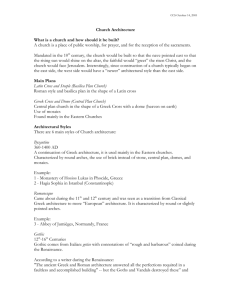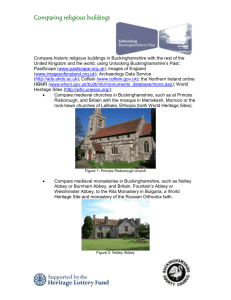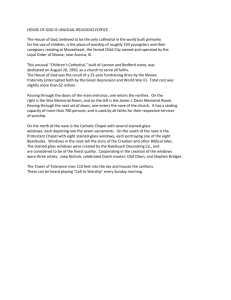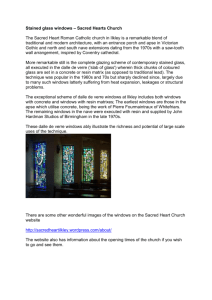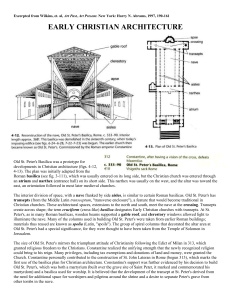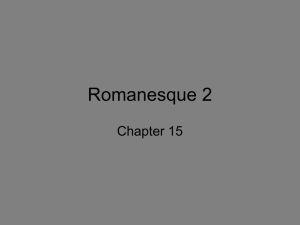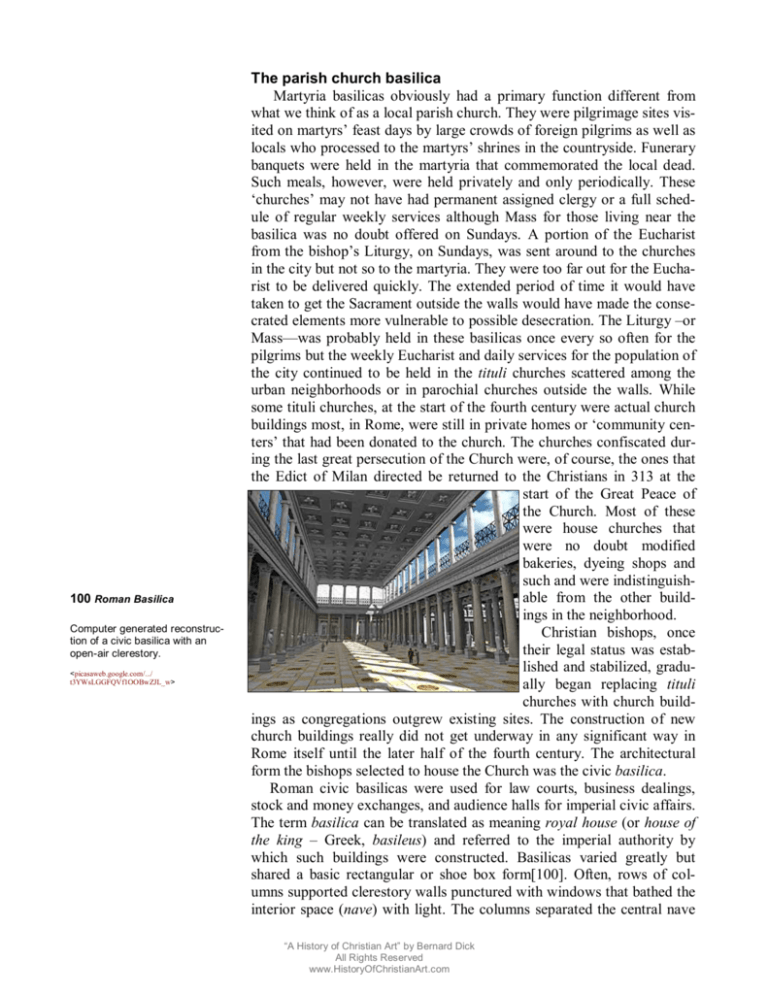
100 Roman Basilica
Computer generated reconstruction of a civic basilica with an
open-air clerestory.
<picasaweb.google.com/.../
t3YWsLGGFQVf1OOBwZJL_w>
The parish church basilica
Martyria basilicas obviously had a primary function different from
what we think of as a local parish church. They were pilgrimage sites visited on martyrs’ feast days by large crowds of foreign pilgrims as well as
locals who processed to the martyrs’ shrines in the countryside. Funerary
banquets were held in the martyria that commemorated the local dead.
Such meals, however, were held privately and only periodically. These
‘churches’ may not have had permanent assigned clergy or a full schedule of regular weekly services although Mass for those living near the
basilica was no doubt offered on Sundays. A portion of the Eucharist
from the bishop’s Liturgy, on Sundays, was sent around to the churches
in the city but not so to the martyria. They were too far out for the Eucharist to be delivered quickly. The extended period of time it would have
taken to get the Sacrament outside the walls would have made the consecrated elements more vulnerable to possible desecration. The Liturgy –or
Mass—was probably held in these basilicas once every so often for the
pilgrims but the weekly Eucharist and daily services for the population of
the city continued to be held in the tituli churches scattered among the
urban neighborhoods or in parochial churches outside the walls. While
some tituli churches, at the start of the fourth century were actual church
buildings most, in Rome, were still in private homes or ‘community centers’ that had been donated to the church. The churches confiscated during the last great persecution of the Church were, of course, the ones that
the Edict of Milan directed be returned to the Christians in 313 at the
start of the Great Peace of
the Church. Most of these
were house churches that
were no doubt modified
bakeries, dyeing shops and
such and were indistinguishable from the other buildings in the neighborhood.
Christian bishops, once
their legal status was established and stabilized, gradually began replacing tituli
churches with church buildings as congregations outgrew existing sites. The construction of new
church buildings really did not get underway in any significant way in
Rome itself until the later half of the fourth century. The architectural
form the bishops selected to house the Church was the civic basilica.
Roman civic basilicas were used for law courts, business dealings,
stock and money exchanges, and audience halls for imperial civic affairs.
The term basilica can be translated as meaning royal house (or house of
the king – Greek, basileus) and referred to the imperial authority by
which such buildings were constructed. Basilicas varied greatly but
shared a basic rectangular or shoe box form[100]. Often, rows of columns supported clerestory walls punctured with windows that bathed the
interior space (nave) with light. The columns separated the central nave
“A History of Christian Art” by Bernard Dick
All Rights Reserved
www.HistoryOfChristianArt.com
from side aisles. Some basilicas might be plain halls without side aisles.
Depending on the function of the basilica and its size it might have two
or three apses or none.
101 Hierarchic Order
The red area symbolizes Christ,
the Head; the yellow symbolizes
the faithful, the Body.
Hierarchic order
One theological concept dictated the adaptation of the civic basilica for
Christian worship. Beginning with St. Paul, Christians conjured the visual metaphor of the human body as a way to describe the Church; Christ
as the head and the faithful as the body. The Eucharistic sacrifice that
constitutes the core of Christian Liturgy has always been understood as
being offered by the priest and people together but the bishop or priest
officiating at the altar had the unique role of standing in the place of
Christ, the Head of the Body. The architectural setting for Christian worship needed to express this metaphor of the body. To accomplish it the
apse and entrance of the civic basilica plan were positioned opposite each
other on the short sides[101] in the church basilica plan. This rearrangement created a longitudinal orientation with the apse representing the
head (Christ) and the long nave, the body (congregation).1 The metaphor
was
further reinforced by the same direction the clergy and people faced
when praying –East.
While the three aisled rectangle with apse can be considered the basic
102 (left) Cancellus Railing
Graphic reconstruction of a basilica on the Tsarevets hill in
Veliko Tarnovo dating back to
early 6th c.
<liternet.bg/.../nasledstvo/ikonostas_en.htm >
103 (right) Templon
T.F. Mathews, The Early Christian Churches of
Constantinople: Architecture and Liturgy
(University Park, P.A./London 1971) pp. 162-73;
Atlas pls. 430-50
normative form of the church basilica it
is really the theological concept that must be kept in mind as there are
numerous variations to this basic design, some in which the longitudinal
nave as well as the apse are given over to the clergy. The concept of hierarchy, however, always results in a distinction among the spaces of the
building according to the roles played
in the ceremonial by clergy and laity. In addition, the spaces within the
church are not all equal in sacredness. Hierarchy applies in that respect as
well.
Indicating hierarchic spaces
The distinction between the roles of the clergy and laity was made clear
in most church basilicas at or near the border of the area of the altar and
apse. In the civic basilica, the apse and an area extending several feet out
“A History of Christian Art” by Bernard Dick
All Rights Reserved
www.HistoryOfChristianArt.com
104 Cancellus with Fastigium
Reconstruction of a cancellus
from 5th c. Olympia, Greece, by
A.K. Orlandos
Edward Foley , From Age to Age: How Christians
Have Celebrated the Eucharist, (Chicago, Liturgy
Training Publications 1991) p47
105 Solea
Ceremonial walkway.
Edward Foley, From Age to Age: How Christians
Have Celebrated the Eucharist, (Chicago, Liturgy
Training Publications 1991) p47
106 Ambo
Pulpit.
<
from it was reserved for magistrates, judges, and other officials conducting whatever business was at hand. To keep the apse free of encroachment by the crowd —there were no seats— a meter high cancellus
(railing)[102] of marble panels sometimes separated the apse from the
nave. It crossed in front of the apse at least a few feet out from what is
called the chord of the apse. This kept the crowd from coming right up to
the apse and wandering into it. The cancellus of the civic basilica was
kept as part of the plans for church basilicas and served the same purpose. The railing or cancellus not only controlled the crowd in the church
basilicas but also served as a symbol of hierarchic distinctions as only the
clergy could pass through it. The cancellus also marked off the most sacred part of the church, where the altar was located. The area of the altar
and the preserve of the clergy is called the chancel.
Often the cancellus could have a prominent architectural presence. It
sometimes supported small columns spaced a few feet apart that, in turn,
supported a continuous line of lintels or an architrave. This type of cancellus barrier is called a templon.[103] The spaces between the columns
of the templon were often hung with curtains drawn shut between Liturgies. This, of course, intensified the sense of sacredness and mystery.
An imposing cancellus or templon included a
fastigium[104], a pedimented or arched gateway
over the central passage into the chancel. We will
talk more about both the templon and fastigium
later as we explore the theological significance of
the various parts of the early Christian basilicas.
The solea and ambo
A hierarchic feature sometimes introduced into
church designs was the ceremonial walkway
(solea)[105] that began about halfway down the
center of the nave from the entrance and extended to the chancel. It was sometimes designed
in conjunction with the bema (raised platform)
and ambo (pulpit)[106]. The width of the walkway varied from just a few feet in some churches
to nearly half of the nave in others, therefore
doubling as a bema. It was bordered in the same
way as the cancellus with panels of marble about
a meter high. The purpose of the solea is rather
interesting. Congregations assembled inside the church to await the arrival of the bishop and his clergy.2 (In the Eastern Church, in some places,
the congregation assembled outside and entered at the same time as the
clergy.) The entrance of the bishop was accompanied by the singing of
psalms or litanies. He and the clergy processed down the center of the
nave and onto the restricted walkway, continuing on into the chancel.
Like the cancellus, the solea had the very practical purpose of crowd control as the fenced-off walkway kept the center free for the bishop, priests
and deacons to make it to the chancel unhindered. The solea was also
“A History of Christian Art” by Bernard Dick
All Rights Reserved
www.HistoryOfChristianArt.com
107 (above) Santa Sabina,
utilized when the scriptures were brought into the nave for readings by
the lectors. For that and for addresses by the bishops and priests, the
bema —a carryover from the Jewish synagogue as well as the civic basilica— was placed near the center of the nave and enclosed by a railing of
marble panels. The congregation gathered around the bema to listen to
the lectors. The bema eventually evolved into —or was fused with— the
slightly higher ambo. The ambo was generally down a bit on one side of
the nave, near the columns. In the Eastern Churches, the readers/lectors
and chanters often stood in an enclosed space around the ambo, at floor
level. Basilicas in the Western provinces rarely included an ambo as sermons were not required in the Liturgy of the Latin West for several centuries.3 Readings in those instances were done from the bema. In the
Eastern Church the bema eventually was a term that applied to the chancel or altar area.
These interior structures, the cancellus, bema, and solea formally delineated which spaces were reserved for clergy and which spaces
were more sacred.
Rome, ca. 4th c.
<anatomy almanac.blogspot.com/.../atriumpl.
html>
108 (right top) Nave, Santa
Sabina, Rome, ca. 4th c.
109 Reconstruction of façade,
narthex, and nave, San Vitale,
Rome, ca. 401-17
Richard Krautheimer with Slobodan Curcic,
Early
Christian and Byzantine Architecture (Revised),
(New Haven and London, Yale University Press,
1986) ) p 170
Variations
By the end of the fourth century a
standard church basilica form for
ordinary worship had been adopted
pretty much all over the Roman
Empire[107,108]. Regional variations never included a rejection of
the basic plan of a long nave terminating in an apse and flanked by
side aisles. Some naves might be
elongated or, conversely, stunted
but were always easily identifiable.
Here and there centralized plans
based on the circle, octagon, or
square would appear but those always remained, in the West, exceptional. We will discuss the centralized plans later in this section.
A narthex or entry hall transitioned the exterior and interior
space in the standard plan[109].
Sometimes two halls served this
purpose: an exonarthex or colonnaded outer porch gave way to a
colonnaded esonarthex or interior
transverse aisle[111]. It was also always preferable that the entire complex be preceded by an atrium if the site would allow for one. Finally,
after Constantine, churches were constructed on an East-West axis: façade or entrance side on the West end and the apse on the Eastern end.
“A History of Christian Art” by Bernard Dick
All Rights Reserved
www.HistoryOfChristianArt.com
110 detail of Nave Mosaic toward the East, S. Apollinare
Nuovo, ca. 500
Curtains in this mosaic are
shown hung between columns
in the imperial palace. Curtains
were similarly hung between
nave columns in some church
basilicas.
111 (top, middle) plan,
Church of the Acheiropoietos,
ca. 450-70
Edited illustration based on: Richard Krautheimer
with Slobodan Curcic, Early Christian and
Byzantine
Architecture (Revised), (New Haven and
London, Yale University Press, 1986) p 100
Previously, the apse might be in the East, West or North depending on
local custom and dictates of the site. Symbolically, by placing the apse in
the East the Church assembled to worship in anticipation of the ‘second
coming’ when Christ will approach out of the Eastern sky. While the
spaces remained essentially the same, Liturgies sometimes unfolded differently between the Eastern and Western Churches with spaces within
the basilica utilized in different ways. Clergy in the West were pretty
much assigned the areas of the apse and chancel; the congregation occupied the nave and side aisles. In some localities of the East the clergy extended its area of activity forward to include the nave; the congregation
occupied the side aisles (men on the right and women on the left).4 In addition, parapets (a short barrier perhaps one to two feet high with a similar width) filled the space between the columns that separated the nave
from the side aisles. To step over a parapet would be awkward and difficult and so they were meant to restrict movement into the nave from the
sides.[111,112] The barrier nature of the parapets was reinforced by cur-
112 (top, right) Parapet
<liternet.bg/.../nasledstvo/ikonostas_en.htm >
113 Cross Transept Basilica,
St. John, Ephesus, ca. 450
Edited illustration based on: Richard Krautheimer
with Slobodan Curcic, Early Christian and
Byzantine Architecture (Revised), (New Haven
and London, Yale University Press, 1986) p 106
tains suspended between the columns and gathered at the center, or tied
to the columns[11]. The congregation, participating from the side aisles
would catch only glimpses of the ritual action taking place in the nave.
“A History of Christian Art” by Bernard Dick
All Rights Reserved
www.HistoryOfChristianArt.com
114 Tripartite Transept
115 (right, top) Triconch Transept, Hermopolis Cathedral,
ca. 430-40
116 (right, bottom) Trilobe
Apse, Deir-el-Abiad, ca. 440
Edited illustration based on: Richard Krautheimer
with Slobodan Curcic, Early Christian and Byzantine Architecture (Revised), (New Haven and
London, Yale University Press, 1986) p 114
117 Elevation Plan, Gallery,
Church of the Acheiropoietos,
ca. 450-70
Edited illustration based on: Richard Krautheimer
with Slobodan Curcic, Early Christian and Byzantine Architecture (Revised), (New Haven and
London, Yale University Press, 1986) p 114
The chancel and altar were also screened from full view by a templon
that might also be hung with curtains. This arrangement brought out the
significance of two high points in the
Liturgy when Christ reveals himself:
first, in the gospel reading which
takes place in the nave and, second,
in the consecration which takes place
on the altar in the chancel.5 The experience was one of a veiled view of
the appearances of Christ and reflected a general belief that the Mass
or Eucharist should be experienced
but not completely understood.6
Transepts
About the only major variation in
the standard basilica itself was the
inclusion —mostly in the Eastern
provinces of the Empire— of transepts inserted between the nave, side
aisles, and the apse. The martyrium church of the Holy Apostles in Constantinople no doubt inspired these cruciform churches. Continuous transepts like that in St. Peter’s basilica in Rome were not repeated in the
West until about 800, but in Greece, the Balkans, Asia Minor, and Egypt
two types of transepts were frequently used. The cross transept[113] plan
continued the colonnaded side aisles around the transept side wings, and
the tripartite transept[114] ‘screened’ the central bay from the two arms
by arcades. Variations included triconch transepts[115], in use in Egypt,
and are strongly reminiscent of triconch mausolea. In these the ends of
the transepts form exedra or apses in imitation of the main apse, itself
springing directly from the transept. Perhaps derived from the triconch
transepts are trilobe apses[116], also Egyptian, in which the apse is laid
out in triconch fashion. The center conch was reserved for the bishop’s
throne. The left one served the preparation of the bread and wine and
then the guarding of the reserved Eucharist; the right one for storing the
liturgical books.
118 Nea-Anchialos, Basilica A,
ca. 470
This basilica in Thessaly is not a
cathedral but does include a number of aspects of some fifth century churches: cross transept,
parapets, diaconian or offering
room, narthex rooms, attached
baptistery, counter apse, and a
treblon.
Edited illustration based on: Richard Krautheimer
with Slobodan Curcic, Early Christian and Byzantine
Architecture (Revised), (New Haven and
London, Yale University Press, 1986) p 122
Galleries
Basilicas in and around Constantinople —Constantine’s ‘New
Rome’ in the East— often had
galleries[117] over the side and
transept aisles. These were added
initially to churches in Constantinople and came to be the reserve
of the imperial court and emperor’s family. The galleries may also have
been added in some basilicas to offset the loss of space available for the
congregation when the nave was given over to the clergy.
“A History of Christian Art” by Bernard Dick
All Rights Reserved
www.HistoryOfChristianArt.com
119 Nave Exedra, ca. 418
120 Apse Tribelon and Nave
Altar, African basilica, reconstruction of mosaic from
Tabarka, ca.400
Edited illustration based on: Richard Krautheimer
with Slobodan Curcic, Early Christian and Byzantine Architecture (Revised), (New Haven and
London, Yale University Press, 1986) p 190
121 Apse Tribelon, Tabarka
mosaic, ca. 400
<www.tunisie.com/mosaiques/mosaic49.htm>
122 Synthronon, Agh.
Nicholaos, 4th c.
<rolfgross.dreamhosters.com/.../Paros/Paros.htm >
Auxiliary rooms
Other than the occasional use of transepts, variations in the standard basilica were not significant although ground plans might appear complicated. Auxiliary needs of the Liturgy were served by separate rooms
flanking the apse and/or rooms at the ends of the side aisles or either end
of the narthex.[118] In the Eastern provinces, the people dropped off
their offering of bread for use in the Liturgy on their way into church at
the diaconicon[118] which was usually one of the rooms situated at the
ends of the narthex. The preparation (prothesis) of the bread took place in
the same room in which the gospel book was stored[118]. Vestments and
other items needed for the Liturgy were also kept in the diaconicon.
Sometimes a skeuophylakion (separate building) near the front of the
church served this purpose. In the Western provinces the people dropped
off their bread offering at one of the rooms flanking the apse, at the end
of a side aisle, or at one or both of the transepts. The deacons in both the
Eastern and Western rites took charge of receiving and selecting some for
consecration. Baptisteries[118] —found only at cathedral churches—
were sometimes attached to the main building and sometimes separate.
The consignatorium –a room associated with the sacrament of confirmation— was usually an attached
room, sometimes flanking a side
aisle.
Some flanking transept rooms,
like those in the Near Eastern hinterlands, were martyrs’ chapels containing shrines and reliquaries.
Syria also had a unique tradition
that included an exedra (clergy
bench) situated in the nave facing
the chancel and apse.[119]7 Two
entrances were on one side of the
building so that men and women
could enter separately and proceed
to their places without mixing: men
to the front of the exedra and
women, behind.
Incidental variations
There were numerous minor local variations. The size and shape of the
chancel and how far it might extend down the nave was dependent on
local liturgical custom. North African churches often placed the altar
down toward the center of the nave.[120]8 Sometimes the chancel was
preceded by a solea, sometimes not. As sermons were generally not required in the West until the eight century many basilicas in those provinces did not have an ambo. A clergy bench (synthronon)[122] with a
throne for the bishop lined the back wall of the apse in most basilicas in
“A History of Christian Art” by Bernard Dick
All Rights Reserved
www.HistoryOfChristianArt.com
123 Lashlar Blocks, Binbirkilise, Church no. 1, ca. 600
This masonry technique was
characteristicof architecture in
Palestine and Jordan as well as
other Mosaic floors were common
in the Aegean coastlands and in
areas influenced by Aegean
church architecture such as
Northern Italy.
124 (right, top) Qalb Lozeh, ca.
450
www.mithratravel.biz/.../progsy /prog14j.htm
the West but in the East it could be in the nave. African coastal churches
made use of a tribelon[121] archway between the apse and the nave.
[21,22]
Masonry
Near Eastern and North African basilicas are made of large blocks of
stone[123, 124] and exhibit a heavy, almost ponderous, appearance with
125 (right) Theodosian Walls,
Constantinople,
ca. 400
Walls of mortared rubble faced
with bands of stones and brick.
Common in the Aegean region.
126 (far right) Apse of Santa
Sabina, Rome, 422-32
127 Mosaic Flooring, ca. 500
Mosaic floors were common in
the Aegean coastlands and in
areas influenced by Aegean
church architecture such as
Northern Italy.
squat columns and small
windows. The exteriors often exhibit a powerful feeling with blocky
masses of geometric forms. Doors and windows are defined by strong
bold frames. In many areas where there were no forests, the ceilings were
vaulted in stone. Walls in the area of Constantinople and the coast of
Asia Minor are often made of mortared rubble finished off with brick and
stone bands[125] or, sometimes, mortared rubble faced with bands of
small stones or brick.
The columns and capitals of the nave and aisles in Western church
basilicas were almost always spoils from older buildings, sometimes very
carefully chosen for matching details, sometimes not. Ceilings in Western basilicas were open timbered; the roof pitched and covered with clay
tiles. The half domed ceiling of the apse was usually concrete or brick or
both, with marble revetment at least on the bottom half of the interior
wall[126]. Those in North African and Near Eastern churches were made
of cut stone. Fresco or mosaic covered the half dome’s interior ceiling.
Generally there were windows in the apse walls; they might number anything from one in the center to a horizontal bank of several[126]. The
“A History of Christian Art” by Bernard Dick
All Rights Reserved
www.HistoryOfChristianArt.com
128 Baptistery of St. John
Lateran, Rome, 330
campus.belmont.edu/.../ECArchThree.html
129 Centralized Plan, Church
of the Theotokos, Mount Garizim, ca. 484
Edited illustration based on: Richard Krautheimer
with Slobodan Curcic, Early Christian and Byzantine Architecture (Revised), (New Haven and
London, Yale University Press, 1986) p 157
130 Centralized Plan, SeleuciaPieria, ca. late 5th c.
Similar to the church of San
Lorenzo in Milan
Edited illustration based on: Richard Krautheimer
with Slobodan Curcic, Early Christian and Byzantine Architecture (Revised), (New Haven and
131 Sto. Stefano, Rome, 46883, original lines of building.
Cruciform was sometimes combined with circular or square
plans
campus.belmont.edu/.../ECArchThree.html
floors in the West were paved with flat
flagstone and usually consisted of
graves —even in the cities— in imitation of the martyria. Floors in many of
the Eastern churches especially in the
Aegean coastlands were mosaic stone or
marble laid out in beautiful patterns and
decorative figurative imagery.[127]
Baptisteries
Baptisteries throughout the Empire were
traditionally separate from the church
building and were octagonal in shape,
the font occupying a central space. An
colonnaded ambulatory with a lower
roof surrounded the nave.[128] The
similarity to the shape of the mausoleum is obvious and deliberate as —in
baptism— the candidate dies to sin in
the water of the font and rises again to a
life in Christ. The octagonal shape is
symbolic of regeneration and resurrection as the universe as a whole began its
existence on the eighth day of creation,
and Christ rose from the dead on the
eighth day after the commencement of
his passion.9
Centralized churches
Church plans based on a circle or polygon are so exceptional that they are almost always associated with a special
situation. In fact, they are often found at
shrine sites. One immediately thinks of
the octagonal end of the Basilica of the
Nativity in Palestine which covers the
grotto of Christ’s birth or the Church of
the Holy Sepulcher in Jerusalem. These
forms are associated with mausolea and
therefore appropriate as a martyr’s
shrine. Cruciform churches are often
discussed along with centralized forms
when considering exceptions to the
standard basilica plans. More than likely they were designed in imitation
of the Church of the Holy Apostles in Constantinople, a mausoleum. The
cruciform plan is sometimes combined with round forms or square forms
as we see in the Church of Santo Stefano in Rome[131]. Churches designed in the round are somewhat problematic. There is a certain liturgical awkwardness associated with the placement of the altar in the center.
Unless the altar is raised to a significant height and the altar covered by a
“A History of Christian Art” by Bernard Dick
All Rights Reserved
www.HistoryOfChristianArt.com
131 Cross in Square Plan,
Church of the Prophets, Apostles, and Martyrs, Gerasa, ca.
465
This form w ill become, in the
Byzantine Empire, a standard
church design.
Edited illustration based on: Richard Krautheimer
with Slobodan Curcic, Early Christian and Byzantine Architecture (Revised), (New Haven and
London, Yale University Press, 1986) p 158
prominent ciborium or baldachin,
a sense of the sacred precinct of
the chancel is minimized. In addition, the round or polygonal plan
is not conducive to straight processional linear movements —
either physically or symbolically.
The problem for Christian theological expression and symbolism
is significant. Chancels and altars
therefore are often situated in an
apse on the edge of the circle or polygon, opposite the main entrance.
[28,29] The chancel sometimes extends out from the apse interrupting
the flow of the ambulatory by a cancellus. In this way a longitudinal direction is forced upon the centralized form. Round or polygonal plans
never seriously challenged the standard basilica form in the West. Eastern churches however did develop a cross in square plan that retained the
longitudinal solution to centralized plans by placing a projecting apse on
one side and, usually, the entrance opposite it.[131]
In the next section we will look at the influence of imperial court
ceremonies on church design and interpretations that drew comparisons
of Christian Liturgy and church design with the Jerusalem Temple and
liturgies of the Old Testament.
________________________________________________________
1 Slattery,
Bishop Edward, Ad Orientem, (Eastern Oklahoma Catholic 2, Diocese of
Tulsa, Tulsa, 2009) p. 2
2 Hugh Wybrew, The Orthodox Liturgy: The Development of the Eucharistic Liturgy in
the Byzantine Rite, (Crestwood, St. Vladimer’s Seminary Press 1996) p. 77
3 Richard Krautheimer with Slobodan Curcic, Early Christian and Byzantine Architecture
(Revised), (New Haven and London, Yale University Press, 1986) p. 168
4 Krautheimer 101
5 Krautheimer 102
6 Krautheimer 102
7 Krautheimer 142
8 Krautheimer 188
9 Krautheimer 95
“A History of Christian Art” by Bernard Dick
All Rights Reserved
www.HistoryOfChristianArt.com

